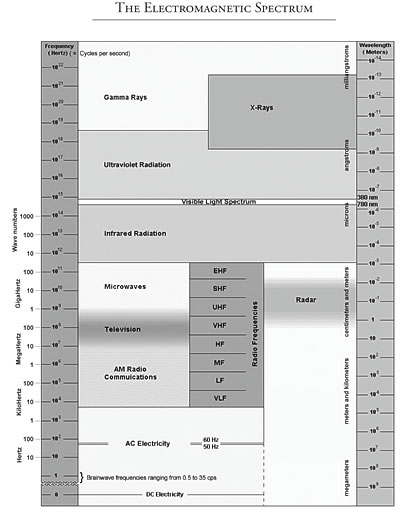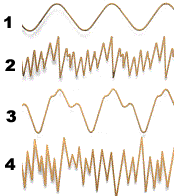Part
Two is also online
Page
1, 2
Introduction
In the 1960s, counterculture hippies were urging us to give peace
a chance (great advice). To expedite that process, it was helpful
to have "good vibrations" – considered so important,
the Beach Boys wrote a catchy song with that title. It was easy
to tell who had good vibes and who didn't. An optimistic, considerate
person was considered "high frequency," while a pessimistic,
disagreeable individual was "low frequency." Not surprisingly,
everyone wanted to be around the folks who had good vibes.
Colloquialism aside, saying that someone is "high frequency"
is based on legitimate science. Every molecule, cell, living body,
and object is comprised of energy that manifests as physical matter.
Some of that energy is detectible as frequencies that belong to
one or more radiation bands in the electromagnetic spectrum. And
these frequencies correspond to biochemical and biological processes
in the body.
In the healing arts, there are different ways to affect matter.
With conventional medical care, the chemical, functional, and/or
structural change in organs, glands, and other tissues are created
either through biochemical manipulation (through drugs) or physical
manipulation (such as surgery). With electromedicine therapies,
healing is achieved by working with the electromagnetic radiation
(emissions) and related energy fields that form, and are emitted
by, physical matter. Broadly speaking, electromedical devices produce
and focus specific frequencies that can be in the form of electromagnetic
fields, electrical current, magnetism, visible light, heat, or other
energy.
Although electromedicine is widely used in Europe, it is less known
in the United States. Few people in developed countries would question
the use of the ubiquitous transcutaneous electrical nerve stimulation
(TENS) unit, which emits small amounts of electrical current to
manage pain. And magnets embedded in the insoles of shoes, also
for pain management, are now a regular item in consumer catalogues.
But electricity and magnetism are primarily used diagnostically
in hospitals – such as with the standard electrocardiogram
(EKG or ECG) to assess the health of the heart and with magnetic
resonance imaging (MRI) to show the inside of the body. Most medical
professionals (and the lay public) are not inclined to take advantage
of less popular electromedical devices because they do not understand
how they work. And those who do use the equipment might talk about
"frequencies" or "energy" without a full grasp
of what these actually are or the science behind the technology.
Fortunately, receptivity to electromedicine is increasing. Health
professionals are expanding their practice (and their success rate)
with safe, holistic technologies. The general public is beginning
to recognize and request electromedicine as an effective and valid
treatment modality. In this article, I will explain what "frequency"
and other terms mean as they are applied to the electromagnetic
spectrum; review electromagnetic energy in living systems; explore
several types of electromedical modalities; and discuss a related
modality: sound therapy.
Electromedicine Throughout History
Healing with electromedicine is not new. From electricity (lightning)
and static electricity (friction) to magnetism (lodestone), from
the sun (for its far infrared and ultraviolet radiation) to visible
light (for its different colored wavelengths), humans have used
electromedicine for healing since ancient times. The therapies were
first based on natural phenomenon, but about the early 1800s, electrical
current began to be harnessed – first for providing light
and then for more sophisticated needs, such as for telegraphing
messages over long distances and running machines in factories.
By the 1900s, electrical power was common in the home as well as
the workplace.
Given the healing properties of many forms of energy, it did not
take long before numerous electronic devices invented for medical
treatments were considered mainstream. In Electrotherapy
and Light Therapy with Essentials of Hydrotherapy and Mechanotherapy,
published in 1949, Richard Kovács describes an impressive
array of electronic equipment, most of which had already been in
use for half a century. This equipment utilized alternating current,
direct current, low frequencies, high frequencies, static electricity,
diathermy, infrared rays, ultraviolet rays, and ultrasonics. Modern
electromedicine practitioners will recognize some of these devices
as forerunners of those used today – if not the machines still
being used, since some devices have not changed much in 100 years.
Some of this equipment included Georges Lakhovsky's multi-wave oscillator,
the Violet Ray (which utilized Nikola Tesla's coil), Edgar Cayce's
wet cell, and Dr. John Harvey Kellogg's electric light cabinet.
The conditions treated were virtually unlimited: muscular aches
and pains, skin conditions, gynecological problems, some heart conditions,
respiratory ailments, gastrointestinal disorders, acute and chronic
infections, and degenerative diseases.
Given the wide applications of such equipment over half a century
ago, what seems remarkable is not the abundance and range of devices,
but rather the resistance to electromedicine today. Of course, the
invalidation of electromedical therapies by the medical mainstream
– and laws passed to suppress the use of such devices –
drove these modalities out of the public's immediate consciousness.
Electromedicine as a valid treatment modality has met with derision
and skepticism from practitioners and laypeople alike. But electromagnetic
fields are successfully used for diagnostic purposes, with the understanding
that living organisms are energy-based. Yet electromedicine as a
valid treatment modality has met with derision and skepticism from
practitioners and laypeople alike. If all sorts of electrical, thermal,
and magnetic devices (as well as the acoustic-based ultrasound)
are used for testing, why can't they just as easily be used for
healing?
As might be expected, the pharmaceutical industry has taken advantage
of people's ignorance and resistance to any modality that seems
new and strange, for if the benefits and track record of electromedical
devices were widely publicized, drug companies would lose billions
of dollars each year. There is little effort by mainstream media
to educate consumers, since it depends on considerable revenues
from the advertising of drugs.
Unlike drugs, each of which can be used only one time by one person
and for just one or two conditions, the many electromedicine modalities
that have emerged in the last century
- are effective,
- are non-invasive,
- support the body's innate ability to heal, instead
of substituting for its natural functions,
- are fairly easy to use,
by laypeople as well as professionals,
- can be utilized over the
course of a lifetime (since they address many conditions),
- can
be used with more than one person, and
- are relatively inexpensive,
considering their range and scope.
How and
why do electromedical devices work? Whether one is a health care provider or
a seeker of health services, understanding the science behind
electromedicine
can make the difference between discerning good vibrations from bad.
The best place to start is with a discussion of the EM spectrum and its
related
component,
sound.
The Electromagnetic
Spectrum and Sound
EM Spectrum Defined by Its Particles and Their Effects
The electromagnetic spectrum (or EM spectrum, sometimes also called
EM waves) is the term used for many different energy oscillations
that comprise our known universe. As shown on the accompanying chart
(Figure 1) of the EM spectrum,
these different oscillations with different characteristics range
from the slower-moving, lower-energy electrons of electrical current
to the faster-moving, higher-energy photons of visible light and
other waves.
Figure
1

It's common to think of
the various EM energy bands as unrelated phenomena that are separate
from each other, since we perceive them differently with our senses
(when we can perceive them at all). We see visible light as color,
we feel far infrared radiation as heat, and so on. But all these
energies are sequentially connected to each other as a continuum
of waves in the EM spectrum. The nature of the particles depends
on how fast they are moving and the qualities that they exhibit.
Humans perceive most of the EM frequencies indirectly through their
effects, rather than directly perceiving the frequencies themselves.
We label and differentiate EM waves from each other, according to
how they manifest physically. By harnessing the waves with various
electrical devices and some passive (non-electrical) materials,
we can produce tangible physical phenomena. For instance, we access
frequencies on the radio spectrum with an antenna, which transmits
and receives radio broadcasts. An X-ray machine utilizes certain
radiation on the X-ray band, which allows us to see inside the body,
and so on.
The existence of an EM field includes both electric and magnetic
fields. An EM field has certain properties, electrical fields have
other properties, and magnetic fields possess yet others. Electrical
and magnetic fields can be separated from EM fields as their own
distinct energies. They can also exist in EM fields in varying proportions.
Frequency, Wavelength, and Amplitude
All the energies in the EM spectrum have different frequencies. The term frequency
pertains to the number of cycles per second (CPS) at which a wave vibrates
or moves. (The designation "CPS" has now been replaced with hertz,
or Hz.) Waves also have different sizes or lengths, with various terms used
to measure the length such as micron, angstrom, nanometer, and meter. (The
waves shown below are sine waves. Different shaped waves will be discussed
later.)
Figure 2: Key EM Wave Definitions
|
|
Wave is
a movement
of energy along a directional axis.
Frequency is a rate
of oscillation measured by the number of
wave cycles per unit time (usually in cycles per second,
or Hertz).
Wavelength is the length
or distance between two
identical
points on the wave (which comprises one
complete wave cycle).
This is described with different terms
of measurement, depending on the size of the wave.
Amplitude is the point
of maximum intensity of the signal (usually regarded
as the highest point on the wave). It is comparable to turning
up the volume
on
a radio. |
The peak of the wave is the highest point
on top. The trough of the wave is the lowest point on bottom. The length
of a wave is often measured
peak to peak. (See arrows in diagram below.) Technically, however,
any portion of the wave can be used as a reference point, as long as
the measurement addresses one complete cycle (peak to peak, trough
to trough, etc.).

As the number of waves within a given
space – in other words,
their frequency – increases in number per second, their size
becomes smaller. And as the number of waves decreases in number per
second, their size becomes larger. Put another way, the higher the
frequency (cycles per second or CPS) or oscillation rate of a wave,
the smaller the wavelength. The lower the frequency (CPS) or oscillation
rate of a wave, the larger the wavelength. "A homely comparison
to visualize this," Kovács analogizes, "may be a
motley army of giants and dwarfs, all under orders to reach the same
goal simultaneously; in order to do so the giants step out leisurely,
while the dwarfs run and take hundreds of steps for each one of the
giants."1
In the example below, the frequency of the top wave is higher than
the frequency of the bottom wave, because the distance is shorter
between the peaks of the
waves. The wave forms in this example are simple sine waves.


In
order from slower-moving to faster-moving, frequencies in the EM spectrum
include radio waves, microwaves, infrared light, visible
light, ultraviolet
light, X-rays, and gamma rays. Electric Fields and Magnetic Fields
So far, I have been discussing electromagnetic radiation from the EM spectrum.
Electromagnetic radiation (radiant energy) and electromagnetic fields (non-radiant
spaces in which energy exists) operate somewhat differently. Both come from
electromagnetic sources. However, energy that radiates exists separately
from its source. It travels away from its source, and it continues to exist
even if the source is turned off. EM fields are not projected out into space.
They no longer exist when the energy source is turned off.
Static electricity and magnetism are both static fields that share a complex
and intimate relationship with each other. An oscillating electric field generates
an oscillating magnetic field, and an oscillating magnetic field generates
an oscillating electric field. Each exists at right angles to the other. Most
importantly, when movement is introduced to either a static electrical field
or a magnetic field, they become electromagnetic fields. This will be important
to remember when we later examine a number of different electromedical devices.
Sound
The EM spectrum is often compared to sound, since the two phenomena share many
of the same features. Sound is comprised of mechanical pressure waves in
a compressible medium such as air or water. Put another way, sound is created
when an object moves with enough force to displace (compress) the surrounding
air (or other medium capable of carrying these waves). We hear many of these
waves (air currents) as audible frequencies (sound), because after the air
reaches the ear, it minutely moves the eardrum – a delicate drum-like
membrane – and sends the oscillations to the brain, where they are
then decoded into the noise of traffic, spoken words, a barking dog, music.
The waves of sound could be created by a pen dropping on a desk, someone's
vocal cords being moved in speech, or a violin string being plucked.
The frequency of a wave (expressed as cycles per second) that applies to the
EM spectrum also applies to music (a subset of sound). The pitch of a note
depends on its cycles per second. A lower frequency, or an oscillation rate
of fewer CPS, is slower-moving and produces a lower tone. A higher frequency,
or an oscillation rate of more CPS, is faster-moving and produces a higher
tone.
The feature of cycles per second can be more easily understood and perceived
with music than with random sound (noise). Noise – as well as some harsh
electronic music – is comprised of disorganized waveforms. This disorganization
manifests acoustically as indistinct, muddy pitches. Music, on the other hand,
is comprised of organized waveforms. This organization manifests acoustically
as distinct, discernible pitches. The difference between music and noise can
be seen on an oscilloscope – a testing device that shows visually what
we hear acoustically – with real-time pictures of wave forms (Figure
3). Noise, or random sound, on the oscilloscope appears as irregular wave forms,
while music or pure tones appear as regular wave forms. In Figure
3, in the
examples of music, all the instruments are playing the same note.
For most people,
the acoustic and the visual correlate: music is more pleasing than noise
to the
ear, and
regular
waveforms
are more
pleasing
than
irregular
waveforms to the eye. Figure
3: Comparing Music and Noise Wave Forms on an Oscilloscope
The wave forms
of music on an oscilloscope show organization, with obvious patterns.
The wave forms of noise on an oscilloscope show disorganization, with
no discernable pattern.

Music – Symmetry
1. Tuning fork. Very pure sound; prongs vibrate regularly.
2. Violin. Bright sound, angular waveform. Same pitch as tuning
fork: peaks of the waves are the same distance apart and pass at same
rate as those produced by tuning fork.
3. Flute. Playing same note as first two. Purer sound than that of
violin, so its waveform is more rounded.
Noise – Asymmetry
4. Cymbal. Irregular patterns and jagged, random waveforms, no discernible
pitch. No regular pattern of peaks and troughs.
Photo courtesy of, and text
adapted from, Dorling Kindersley Encyclopedia UK
Page 1, 2
|



![]()
![]()
![]()







